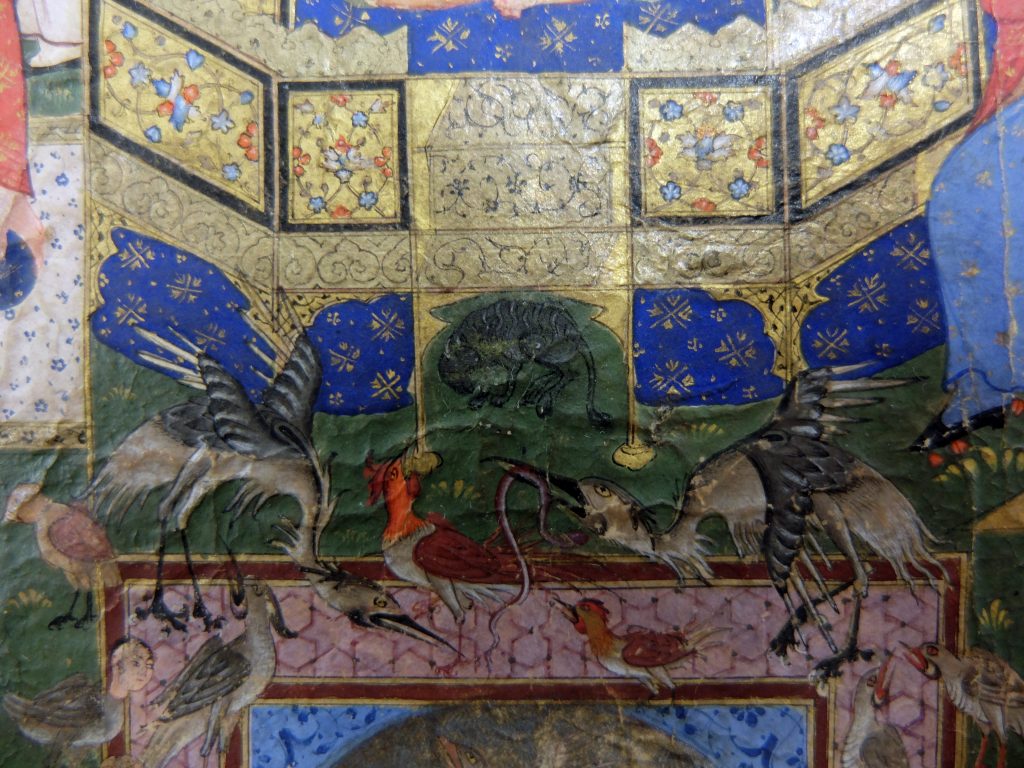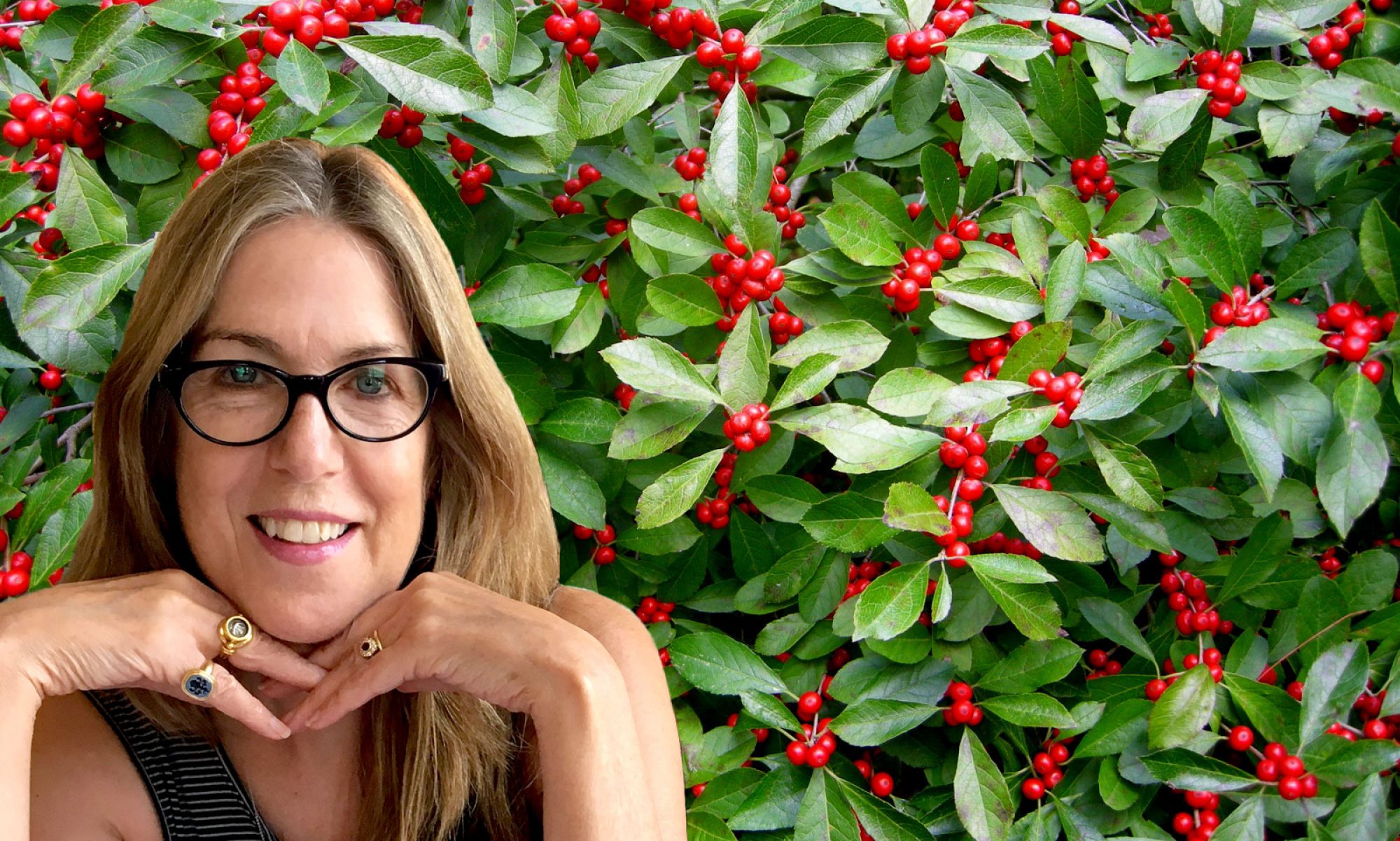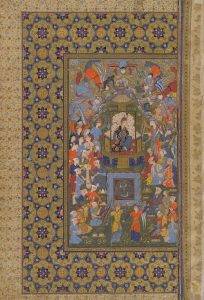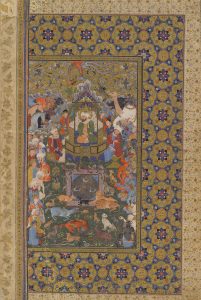A Covert Creature in Princeton’s “Great Persian Book of Kings”
The compositions in sixteenth-century Persian manuscripts are often so varied and complex that it is easy to miss, misread or misunderstand specific details. Such is the case with the so-called Peck Shāhnāma, an illustrated volume of Firdausi’s Book of Kings from Shiraz dated 998/1589-90 belonging to the Princeton University Library (Princeton Islamic Manuscripts, Third series, no. 310). This very modest essay in honor of Holly Davidson, whose important work on the Shāhnāma have contributed so much to the study of Persian literature and culture, attempts to make up for oversights in a previous discussion of the Princeton volume, and to draw attention to one particular and somewhat mysterious feature.[1]
The Peck Shāhnāma opens with a double-page painting depicting King Solomon and his consort Bilqis enthroned in an expansive landscape (folios 1b-2a).[2] As in similar frontispiece compositions dating from the fifteenth and sixteenth centuries, the wise and prophetic ruler is surrounded by a diverse retinue of human attendants, mammals, reptiles and birds, plus mythical and legendary creatures, all representative of his authority over natural and supernatural kingdoms. Some members of this dīvān are recognizable by their traditional role in Solomonic imagery, such as the elderly vizier Asaf ibn Barkhiya to whom the king turns as if in conversation. Others are more fanciful, including the polychrome divs lined up on the composition’s right side, while the animals and birds belong to wide range of familiar and distinguishable species, from majestic elephants and camels to flying cranes and slithering snakes.
The frontispiece menagerie also includes a dark-gray animal with faint white and black stripes tucked between the front legs of Solomon’s throne. What is this hidden creature and what is it doing in this particular and basically covert, or at least easily-overlooked, spot? The overall body size and form, including round head (now partly abraded), legs, paws and tail, point to a feline, and more specifically to a cat.[3] A similar mammal, albeit somewhat larger in size and with a purely black coat, appears held tightly in the arms of a div seated to the right of the throne in various late-fifteenth to early-sixteenth century Solomon images.[4] Interestingly, these same paintings also depict a very large cat with striped or spotted markings, and thus probably identifiable as a tiger or cheetah, stretched out immediately before Solomon.[5] By the later sixteenth century, circa 1570-85, the larger cat has moved further away from the throne, often to the lower part of the composition, and sometimes as part of a pair.[6] Meanwhile, the feline clutched by the div also has undergone certain changes, including a reduction in dimensions and considerable variation in its fur – sometimes black, sometimes black and white, sometimes tawny and sometimes striped. Whatever its coloration, the animal typically sits upright on its haunches, occasionally in front of the throne at right and occasionally in front of Asaf on the other side.[7] In two examples of circa 1590, however, the creature, crouches on all fours beneath Asaf’s seat and faces the left side of the painting, that is, with its back to the rest of the dīvān.[8]
Thus the mysterious cat in the Peck Shāhnāma evolved from looking like a “pet” clutched by a div, to a stand-alone and clearly-visible “intimate” stationed very near Solomon’s throne and apparently taking the place of the large tiger or cheetah, and then to a more discrete yet still noticeable presence in front of or underneath Asaf. In all these examples the cat appears quite benign. The Peck Shāhnāma frontispiece seems to represent another, and possibly more ominous, stage in this progression, one that parallels a distinct modification in the architecture of Solomon’s throne. In illustrations dating from the late fifteenth century through the third quarter of the sixteenth century, the throne typically is furnished with several central steps descending to the ground and with a set of cloth panels to the side. By contrast, in examples from the last decade of the sixteenth century, the staircase has disappeared, although the textile skirting generally remains. In the case of the Peck Shāhnāma the removal of the steps from Solomon’s throne has left a space or gap between the throne’s front legs – the perfect place in which to insert a small animal.
So, at the simplest, compositional level, the dark feline could have resulted from the frontispiece painter taking advantage of space available for a creature already present in the iconography of Solomon’s dīvān. Alternatively, the animal’s “body language” – seemingly curled up like a cat sleeping on a lap and here immediately beneath the prophet’s seat – could be a conscious marker of domesticity in contrast to the “wilderness” represented by the tigers, bears, foxes and other wild beasts who fill the scene. A closer look, however, suggests that the cat is not at rest, but tensely coiled or hunched, with pricked ears and an intense, even fierce, outward stare. Indeed, it appears poised to spring out and pounce, perhaps at the rooster on the edge of the pool that looks up in something like alarm as if sensing danger. Cats are, of course, born hunters. The lurking specimen in the Peck Shāhnāma may represent a menacing or threatening, albeit natural, predator, about to disrupt Solomon’s otherwise peaceful and harmonious kingdom. At the same time, this secret cat serves as a reminder that the iconographic tradition of King Solomon enthroned–where divs exist with humans and lions lie down with deer–constitutes a special, even wondrous, realm that encourages artistic imagination to flourish.
Figures
|
|
|

Footnotes
[1] Marianna Shreve Simpson, Princeton’s Great Persian Book of Kings: The Peck Shahnama (Princeton, NJ: Princeton University Art Museum, 2015).
[2] Simpson, 66-69. For important discussions of such frontispieces, see Serpil Bağcı, “A New Theme of the Shirazi Frontispiece Miniatures: The Dīvān of Solomon,” Muqarnas 12 (1995): 101-11; Lale Uluç, Turkman Governors, Shiraz Artisans, and Ottoman Collectors: Sixteenth century Shiraz manuscripts (Istanbul: İş Bankası Kültür Yayıları, 2006), 291-301. For additional examples, see: Mary McWilliams, ed., In Harmony: The Norma Jean Calderwood Collection of Islamic Art (Cambridge: Harvard University Art Museums, 2013), cat. no. 94, and the Shahnama Project, Scene 1c: http://Shahnama.caret.cam.ac.uk/new/jnama.
[3] Previously this was tentatively identified as a panther, although the white markings would be unusual. Nor would the stripes correspond to the known markings of a leopard or jaguar. Of course, the frontispiece painter may not have been striving for zoological accuracy. Simpson, 67.
[4] Bağcı, figs. 1 and 2; Uluç, figs. 227 and 228.
[5] This animal might be read either as supporting the throne or as providing the footstool at the base of the throne’s steps. In two instances (Bağcı, fig. 2a and Uluç, fig. 228) the feline is winged and perhaps should be identified as the mythical qilin.
[6] Bağcı, figs. 3-4; Uluç, figs. 229 and 240.
[7] Bağcı, figs. 3-4; Uluç, figs. 136-37, and other examples in the Shahnama Project.
[8] British Library Add 27257 fol. 1b; British Library IO Islamic 3540, fol. 1b. Both reproduced in the Shāhnāma Project.


